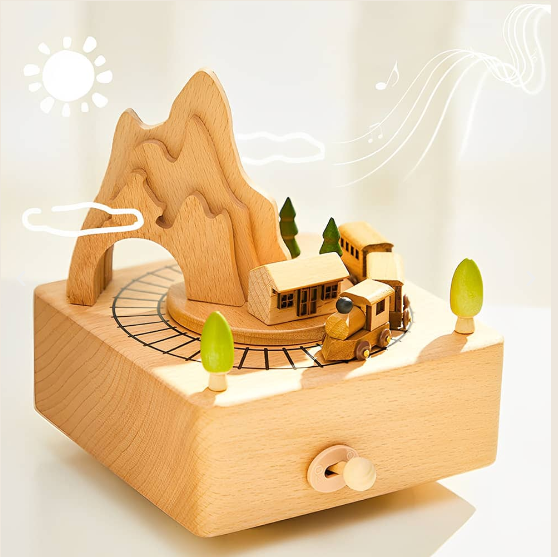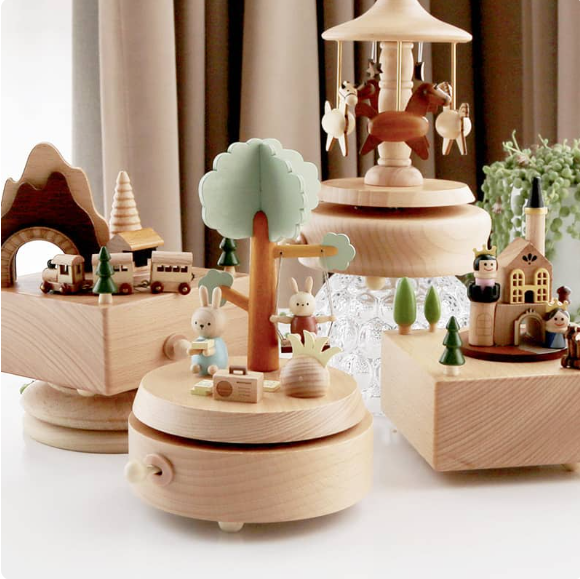From their delicate chimes to their exquisite design, wooden music boxes have charmed generations. The enchantment begins with the turn of a key, awakening a melodious tune, and a whimsical scene set into motion. Let’s embark on a journey exploring the allure of music and movement encapsulated in these timeless treasures.

The History and Evolution of Music Boxes
Our tale begins in the 18th century with the birth of musical automatons, intricate devices that combined the art of music with the science of mechanics. These early music boxes, often disguised as snuff boxes, were prized possessions of European aristocracy, serving as symbols of wealth and sophistication.
Over the years, the music box evolved. The snuff boxes blossomed into tabletop pieces, and materials transitioned from metal to beautifully carved wood. Musical repertoire and intricacy grew, and so did the themes, evolving from simple rotating figures to complex scenes playing out in sync with the melody.
The Artistry of Wooden Music Boxes
Creating a music box is an art form that requires both precision and creativity. The woodwork demands an artisan’s touch, carving intricate details into boxes that range from simple to ornate designs. The true masterpiece, however, lies inside: the musical mechanism. These mechanisms require mechanical finesse, ensuring each note is struck perfectly in time with the rotating scenes.
The motion element of music boxes is where the magic truly unfolds. As the melody begins to play, figures dance, scenes rotate, and the box becomes a stage, bringing to life a world within a world.
The Music of the Boxes: A Melodious Journey
The music within these boxes originates from a cylinder or disc, meticulously studded with pins that pluck the teeth of a steel comb to create melody. This delicate dance between the pins and teeth brings forth a range of tunes, from classical masterpieces to contemporary pop songs.
Historically, music boxes often played popular tunes of their era, making them a melodious time capsule. Today, advancements allow for personalized musical scores, ensuring the music box remains a cherished keepsake for generations to come.
Understanding the music-making process
The heart of a music box lies in its music-making mechanism. This mechanism is either a rotating cylinder or disc, both of which are studded with meticulously placed pins. These pins correspond to specific notes that are played when the pin plucks the tooth of a metal comb as the cylinder or disc rotates. The length, thickness, and alignment of the teeth on the comb define the pitch of each note, creating a tuneful melody.

The mechanical process begins when the music box is wound. This winding stores potential energy that is slowly released as the wind-up key is released. This energy is transferred to the cylinder or disc, setting it into motion. The rotating motion brings the pins on the cylinder or disc into contact with the teeth on the comb, producing the sweet melodies that music boxes are known for.
The variety of tunes: From classical to contemporary
Historically, music boxes were programmed to play popular tunes of their era, including classical melodies by composers like Mozart and Beethoven. Many antique music boxes can be heard playing recognizable classical pieces, their soft, chiming notes providing a charmingly nostalgic rendition of these timeless compositions.
However, as music box technology advanced, so too did their musical range. Modern music boxes are capable of playing a wide variety of tunes, from folk songs to contemporary pop tracks. The development of programmable music box mechanisms has allowed for this expansion in repertoire. These mechanisms can be custom-tuned to play specific melodies, meaning that you could have a music box that plays your favorite Beatles song, a beloved Disney tune, or even a piece of music that you’ve composed yourself.
Whether playing classical or contemporary tunes, music boxes have a unique way of making any melody sound magical, transporting us to a time where music and mechanics danced in harmony.
The Emotional Resonance of Wooden Music Boxes
Beyond the aesthetic and mechanical marvels, wooden music boxes hold a special place in the hearts of many. The power of music, combined with the mesmerizing visuals, evokes emotions that transcend age and time. There’s something undeniably nostalgic about the gentle melodies and slow-paced movements that compel us to pause, listen, and reflect.
Moreover, music boxes often serve as cherished keepsakes, passed down through generations or given as sentimental gifts. Their ability to be personalized — from the choice of music to the engraved messages — makes them unique narrators of individual stories, holding emotional value far greater than their physical size.
The power of music: How music boxes evoke emotion
Music boxes have a unique way of stirring emotions. The melodic tunes and rhythmic movement evoke a sense of nostalgia and tranquility that transcends time and age.
As the melody unfolds, the gentle, chiming notes create a soothing ambiance that can provide comfort, stimulate relaxation, and even trigger cherished memories. The psychological impact of the melodies, combined with the visual appeal of the box and the movement within, adds a sensory richness that can deeply touch our emotions.
Moreover, music boxes often play tunes that have emotional significance to the listener. A lullaby may remind one of their childhood, a love song could recall memories of a romantic relationship, while a festive tune might bring to mind happy family gatherings.
This connection between music and personal experience enhances the emotional impact of a music box, making it more than just a mechanical device, but a vessel for sentiment and emotion.

Music boxes as cherished keepsakes
Music boxes often hold a special place in people’s hearts as cherished keepsakes. Their timeless appeal and ability to evoke emotions make them popular gifts for milestone events such as births, weddings, and anniversaries. The melody they play, often chosen with the recipient in mind, coupled with the visual charm of the box, can encapsulate a special moment or relationship, making the music box a symbol of that memory.
Furthermore, the durability and longevity of music boxes allow them to be passed down through generations, turning them into family heirlooms that hold sentimental value. They are tangible links to the past, their melodies whispering stories of previous generations.
Conclusion
From their modest origins as snuff boxes to their present-day role as cherished mementos, wooden music boxes have experienced a magical transformation. Their melodious allure and enduring charm bear witness to the perfect blend of artistry, technical mastery, and emotional resonance.
As we wind the key and initiate the melody, we are doing more than just listening to a tune or observing a moving scene — we are immersing ourselves in an age-old dance, choreographed by the delightful harmony of wooden music boxes. Here’s to preserving and cherishing this remarkable art form, a living melody that continues to captivate both the young and those who remain young at heart.
 Earl
Earl